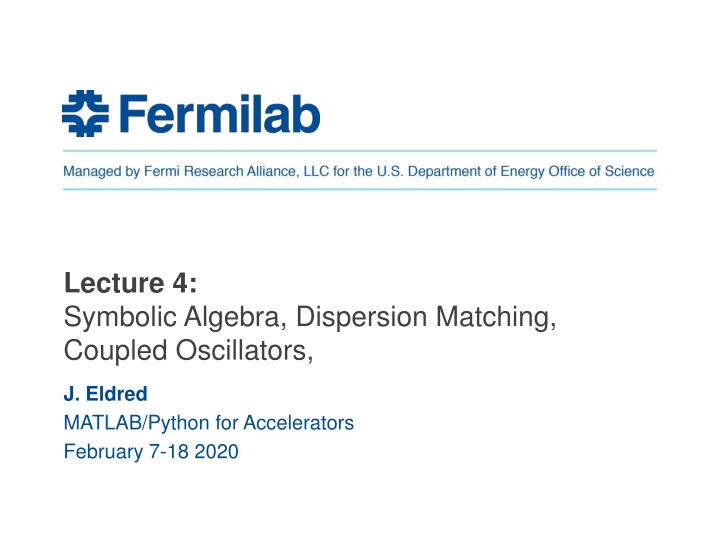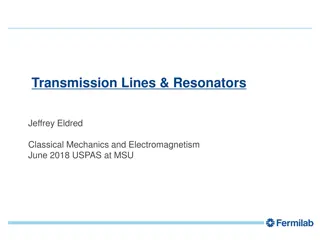
Symbolic Algebra, Dispersion Matching, and Coupled Oscillators in MATLAB/Python
Explore the concepts of symbolic algebra, dispersion matching, and coupled oscillators in the context of accelerator physics. Learn about transverse focusing, dispersive transfer matrices, Chasman Green double-bend achromats, and coupled oscillator systems. Gain insights into solving complex equations and matrices for accelerator design and optimization.
Download Presentation

Please find below an Image/Link to download the presentation.
The content on the website is provided AS IS for your information and personal use only. It may not be sold, licensed, or shared on other websites without obtaining consent from the author. If you encounter any issues during the download, it is possible that the publisher has removed the file from their server.
You are allowed to download the files provided on this website for personal or commercial use, subject to the condition that they are used lawfully. All files are the property of their respective owners.
The content on the website is provided AS IS for your information and personal use only. It may not be sold, licensed, or shared on other websites without obtaining consent from the author.
E N D
Presentation Transcript
Lecture 4: Symbolic Algebra, Dispersion Matching, Coupled Oscillators, J. Eldred MATLAB/Python for Accelerators February 7-18 2020
2 2 Dispersion-Matching 2 3/18/2025 Jeffrey Eldred | MATLAB/Python for Accelerators
3 Transverse Focusing with Off-Momentum Terms Hill s equation can be derived from the Hamilitonian for relativistic co-moving electromagnetic particles in Frenet-Serret coordinates under linear transverse magnetic fields: With the lowest order perturbation in (the fractional deviation from momentum p0) Hill s equation instead becomes: The solution to this equation can be expressed: 3 3/18/2025 Classical Mechanics and Electromagnetism | January 2021 USPAS
4 Dispersive Transfer Matrices Dispersive Transfer matrices are 3x3 and propagate the 3x1 Dispersion vector: Drift: Thin quad: Weak dipole: 4 3/18/2025 Classical Mechanics and Electromagnetism | January 2021 USPAS
5 Chasman Green Double-Bend Achromat Only dipoles generate dispersion, so assume dispersion in the lattice outside of achromatic cell is zero (D=0, D =0). Once dispersion exists a horizontally focusing quadrupole can kick it, just as it would restore any other particle with a deviating horizontal orbit. If the quad kick is perfect, the exit dipole will cancel out the dispersion in a mirror image of the entry dipole which generated the dispersion. To find the necessary quad kick, multiply a zero dispersion vector by the dispersive transfer matrices for these five elements and find what value f1 and L1 need to be in order for the exit dispersion vector to also be zero. 5 3/18/2025 Classical Mechanics and Electromagnetism | January 2021 USPAS
6 6 Coupled Oscillators 6 3/18/2025 Jeffrey Eldred | MATLAB/Python for Accelerators
7 Coupled Oscillators Two oscillators, with some coupling force between them. By taking linear combinations, we can find independent modes: Once we solve the mode, we can then transform back to the original: 7 3/18/2025 Jeffrey Eldred | MATLAB/Python for Accelerators
8 Coupled Oscillators (cont.) How to obtain these modes? Diagonalization of a matrix representation. Matrix Representation Eigenvalues Eigenvectors 8 3/18/2025 Jeffrey Eldred | MATLAB/Python for Accelerators
9 Coupled Oscillators (cont.) How to obtain these modes? Diagonalization of a matrix representation. Matrix Representation Eigenvectors Diagonalization 9 3/18/2025 Jeffrey Eldred | MATLAB/Python for Accelerators
10 Coupled Oscillators in Accelerators Most accelerators are formally designed with independent focusing in the horizontal and vertical plane. In practice, there is usually coupling. 10 3/18/2025 Jeffrey Eldred | MATLAB/Python for Accelerators

